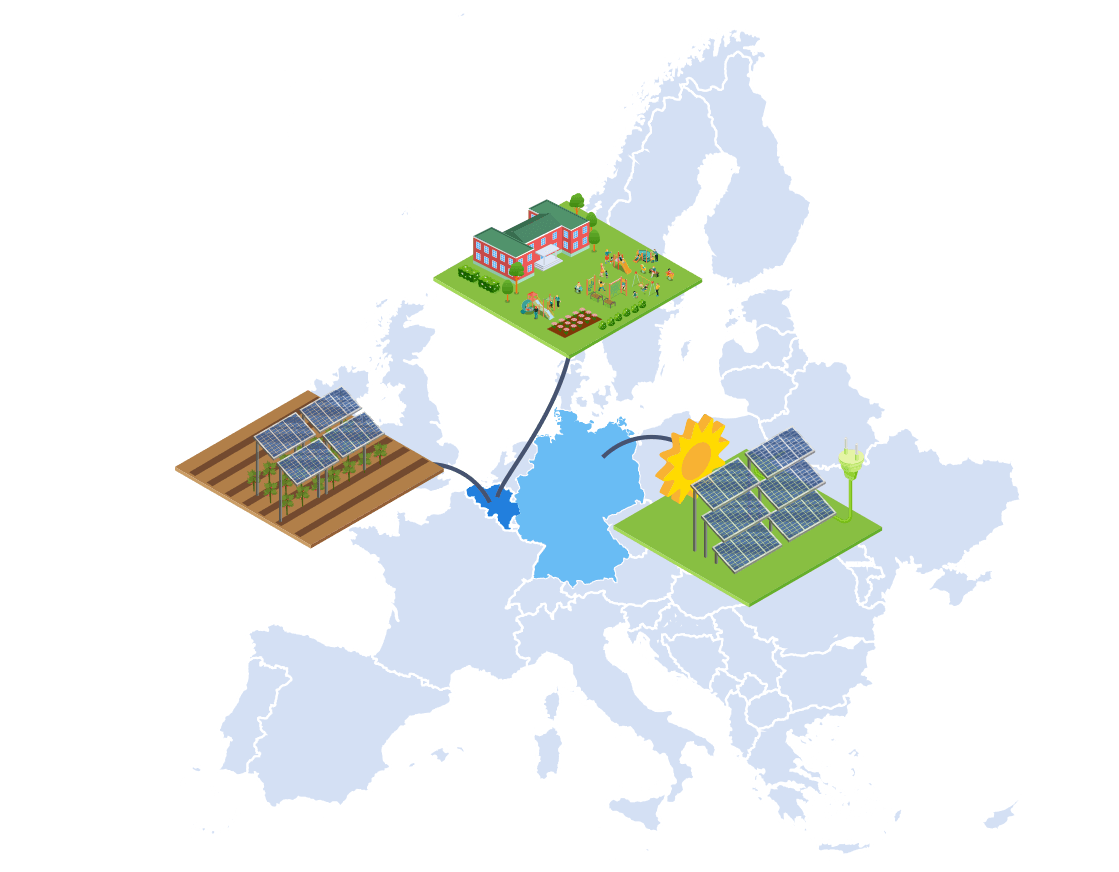
An innovation action (IA), SOLMATE’s mission extends further than merely addressing the reuse and recycling of photovoltaic (PV) panels and electric vehicle (EV) batteries. SOLMATE will also evaluate cost-effective, decentralised energy solutions utilising second-life components across three business models, each with a corresponding demonstrator: Small Off-grid & Plug-in PV [PiPV], AgriPV and Low-income communities demo.
While responsible partners – SUNCRAFT, KUL, W4E are in charge of developing the business cases, another work package will demonstrate them in three real operational use cases. To ensure consistency of the technical and economic feasibility, all three assessments were built using the Strategyzer method by Alexander Osterwalder – an agile framework for developing products, services and business models which tests assumptions. These hypotheses address a business model from a tri-dimensional perspective – desirability, technical feasibility and economic viability. Market penetration is directly dependant on successful applicability on all three fronts.
An outline of the testing assumptions and technical feasibility is available for each demonstrator for the use and information of the SOLMATE consortium partners. Although the deliverable establishes common ground for analysis, emphasis is placed differently, depending on the nature of the demonstration operation.
However, the current volatility of the energy price and the technology availability place a significant doubt on the longevity of the results obtained by these three reports. A second round of assessments, including a more comprehensive evaluation of economic viability, is expected towards the end of the work package, and will take into consideration the latest market information.
Specifications and design for Plug-in PV demo
The PiPV system, a small-scale solar solution for residential use, usually connects to a home electrical system via a standard power socket, prioritising self-consumption of generated electricity. Its conventional configuration comprises PV modules, a micro inverter and, more recently, a battery meant to balance the solar energy intermittence.
Why reuse EV batteries for PIPV systems?
According to 2024 Statista reports, Germany leads the PiPV market with over 356,000 systems registered as of October 2024, reflecting an impressive growth rate of more than 25,000% since 2019. Industry experts estimate that coupled with energy storage solutions, these domestic systems can further enhance their efficiency, providing users with a certain flexibility from the grid and significant financial savings facilitated by storing excess electricity for later use.
Over the course of its framework, SOLMATE will develop and implement innovative technologies for the reuse and recycling of PV panels and EV batteries, demonstrating them within low-cost decentralised energy systems.
But what are the main benefits of coupling already used batteries with domestic photovoltaic systems? Beyond the sustainability aspect, which might be subject to individual sustainability targets, this energy storage solution allows users to replace battery components, enhancing affordability and energy independence. By prioritising reuse over recycling, this solution extends the lifetime of operational applications for a more responsible consumption model. Additional to giving applications a second chance to life, this decentralised energy solution for domestic use can significantly reduce the dependency on critical raw materials.

Despite the obvious contributions to the circular economy, repurposing EV batteries at the end of their economic life into 2nd applications for decentralised energy systems remains a new concept that requires further development to achieve cost-effectiveness, design standardisation and material availability to ensure market competitiveness.
The blueprint for the reuse of second-life batteries in PiPV systems maps the potential partners holding an important role – battery repurposing companies, suppliers and certification institutes, as well as the profiling of the target customers, the key resources and the cost structure.
A first customer survey analysing the desirability of 2nd life applications for decentralised PiPV systems showed that “sustainability” is the main driver, with 88 % of respondents expressing interest in 2nd life battery systems. Survey results also indicate that consumers prioritise features such as long product lifetime, design flexibility and repairability – features that could be easily addressed through a modular design of second-life batteries.
The current design is with 2nd life lithium-ion batteries from cars (NMC chemistry), which are readily available in the near future, due to their early integration in electric vehicles. However, the latest PiPV prototypes propose a different Li-ion chemistry (LFP, Lithium iron phosphate), as researchers anticipate an emerging influx of EoL batteries with a better safety and risk profile, expected to align better with the end consumers’ requirements and the PiPV needs. Yet again, this initial analysis might look completely different if the dynamic electricity tariffs and the grid fees are considered. This could truly unlock the potential of decentralised behind-the-meter energy storage, stabilising the grid and energy prices in a system reliant on intermittent renewables. Small household energy storage systems already constitute over 50 % of Germany’s installed electricity storage capacity. By reducing prices and enhancing the sustainability and longevity of battery systems through modular and second-life battery design, these systems could gain even more traction.
Finally, the deliverable proposes a multi-stakeholder approach involving policymakers, manufacturers and representatives of the research community. An important highlight of the report is the education dimension, working hand-in-hand with all the other incentives to generate public acceptance of the benefits of second-life batteries and decentralised energy solutions.
© visual: SUNCRAFTER
